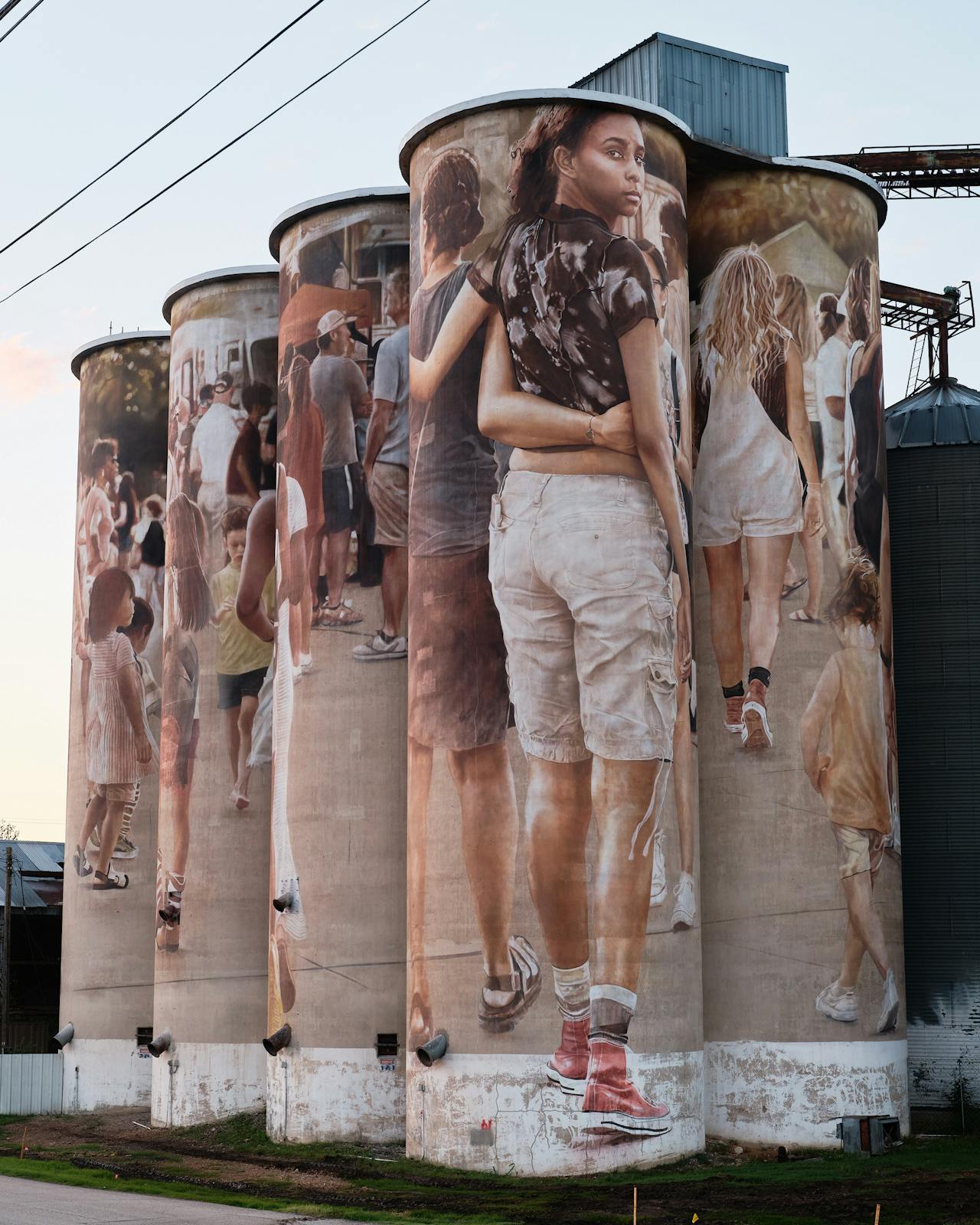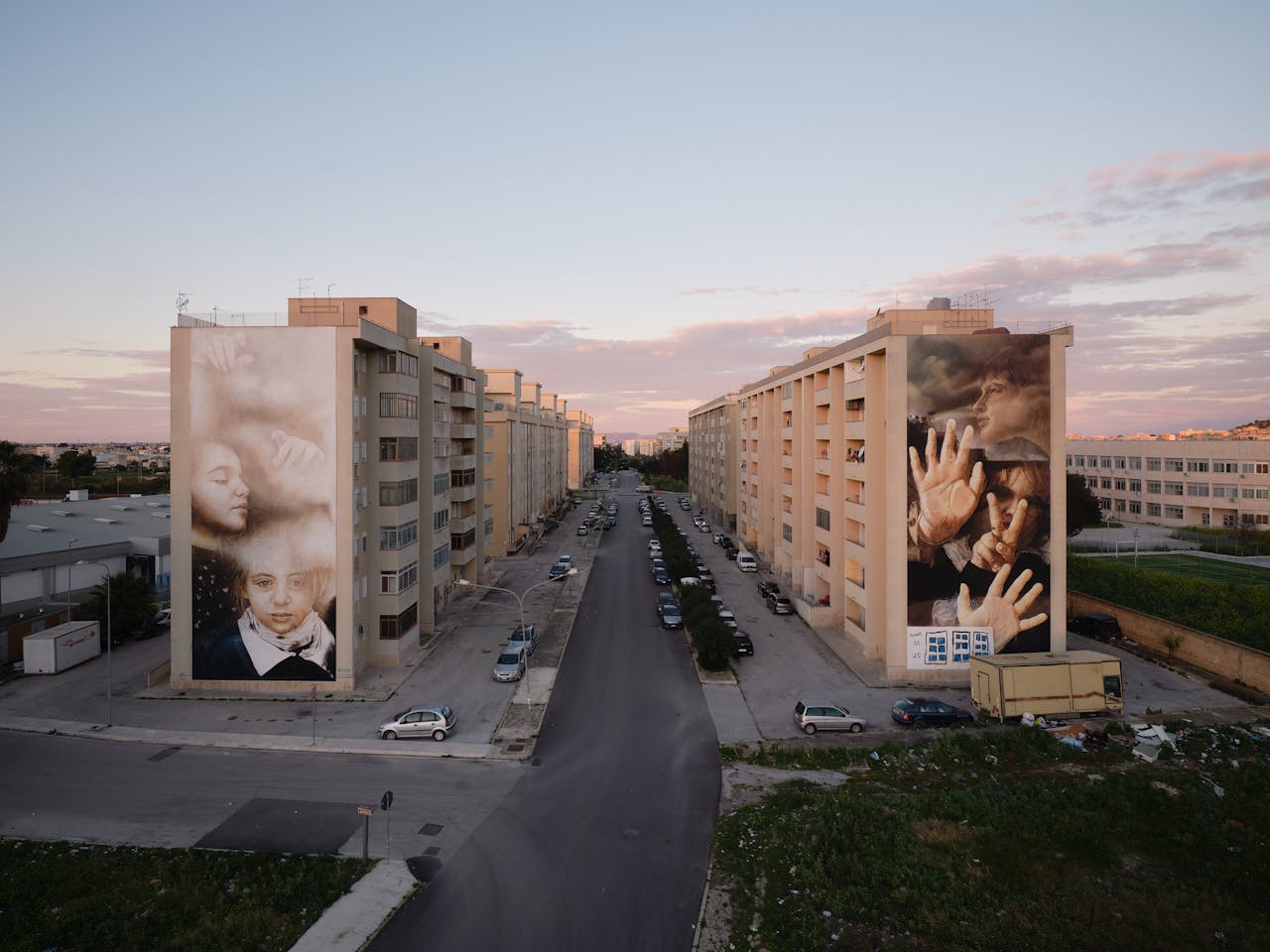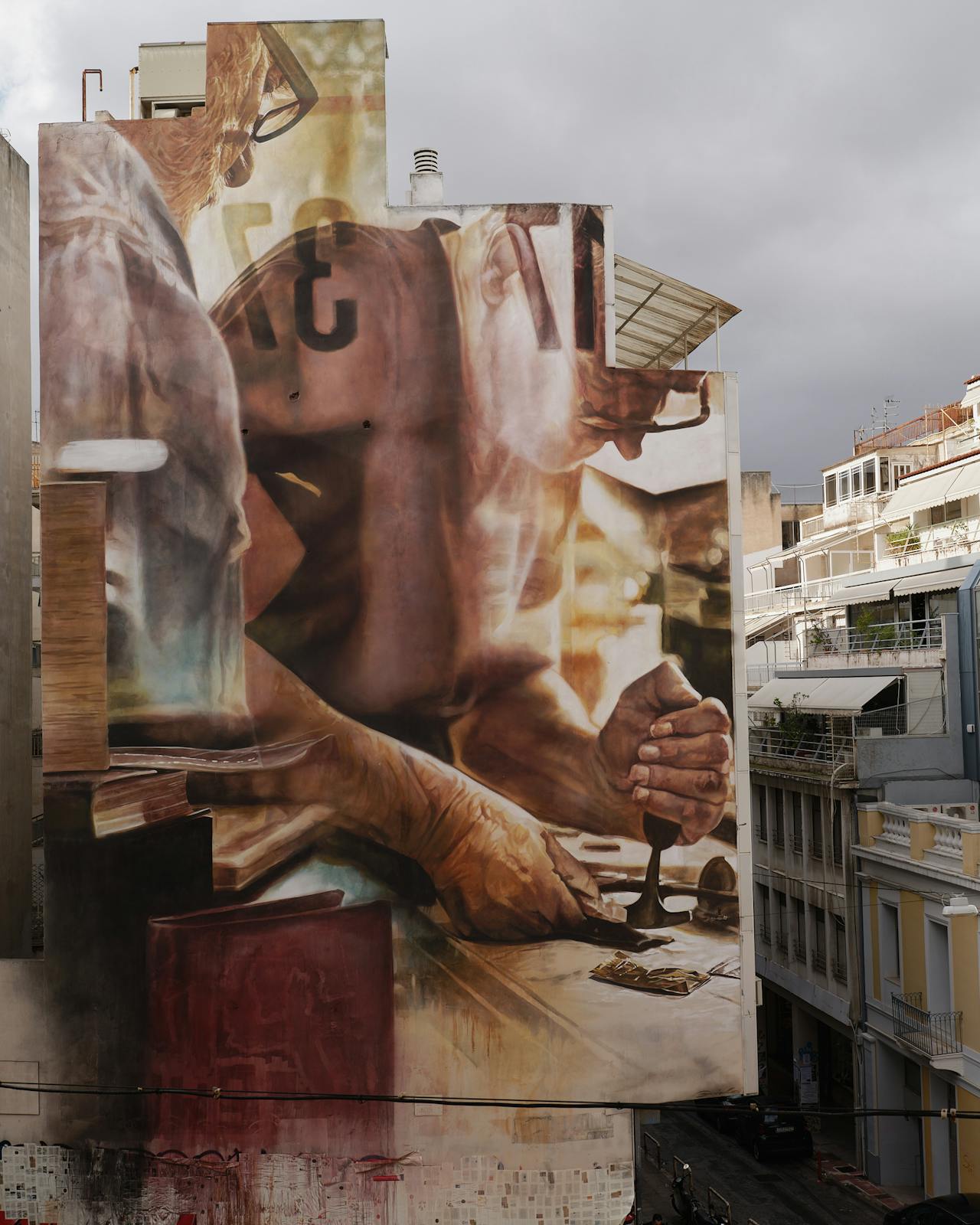Portland Cement Works
New South Wales, Australia,
2018
Completed Mural at Portland Cement Works Portland, NSW, Australia. May 2018 Photographs: Guido van Helten
It was certainly known as a town where cement was manufactured, but its location was to them summed up as ‘Oh, on the Mudgee line,’ or ‘Oh, yes, I know it’s just beyond Lithgow.’ There was a very good reason for this vagueness; Portland lies off both the main highways running to both Bathurst and Mudgee, ...
Photographs by Guido van Helten
Words by Margot Lane Strasburger
Project Details
Project
Portland Cement WorksLocation
New South Wales, AustraliaCommissioner
The Foundations PortlandAnecdotes, Industry and Evocation in regional New South Wales
H. Holland, “Portland’s History Over A Period of 125 Years,” Lithgow Mercury, June–December 1953, 2.
It was certainly known as a town where cement was manufactured, but its location was to them summed up as ‘Oh, on the Mudgee line,’ or ‘Oh, yes, I know it’s just beyond Lithgow.’ There was a very good reason for this vagueness; Portland lies off both the main highways running to both Bathurst and Mudgee, …1
The former Portland Cement Works site commands the skyline of this peripheral settlement with a set of silos, century-old workshops, and variously aged auxiliary structures. These industrial remnants sit directly in the centre of town on Williwa Street, one of the two main thoroughfares dissecting the community. Portland, New South Wales located just west of the monumental and oft-visited Blue Mountains is nestled in the mining heart of the state, the Central Tablelands; and it is known as ‘the town that built Sydney’ due to the quarries, kilns, processing, and cement production that occurred there beginning in the early 1900s until the Works shut its doors in 1991. So essential to this place is the industry found therein that the town owes its name to a common type of cement used around the world.
It is fair to associate this industrial prominence with the feelings, connections and character that imbues the people living in this place on the fringes. Many here have strong connections to the Cement Works having worked as its labourers, mechanics, fitter and turners, riggers, office staff, shift foremen, blacksmiths and quarrymen. This defunct industrialism and its effects were the natural starting point to explore the nature of this area and how the residents in this town are connected. Spending time in Portland affirms that the past and the memories it has afforded are an ever-present part of conversations, life, and the quotidian nature of this small town.
While many of the memories shared during this project are unique accounts in to the rise of industry, labour conditions, and the simple togetherness that a single-industry town creates, there were also stories and grave memories of personal tragedy, poor working conditions, and devastating loss. By visiting with many different Portland locals, a history of the place was pieced together from their words, scrapbooks, and shared consciousness. The anecdotes shared by the people throughout this project have given unique insight and intimate connections to the design and resulting artwork. Sitting down to speak with various labourers, workers, supervisors, and townsfolk as they shared their photos, newspaper clippings and recollections afforded a unique insight in to how much this Site has affected the ebb and flow of the town.
View looking west over the roofs of the old Cement Works towards the centre of town Portland, NSW, Australia. May 2018 Photographs: Guido van Helten
And not only is history a matter of places, but more important still, of people past and present, who through varying fortune wove into its history the very fabric of their lives.2
H. Holland, “Portland’s History Over A Period of 125 Years,” Lithgow Mercury, June–December 1953, 1.
At its zenith, the Portland Cement Works provided a solid livelihood and drew people from all over the region to work in the quarries and processing facilities. It is a vast property with brimming lakes occupying the old quarry sites, multiple kilns including the original brick bottle kilns – now heritage listed, and numerous silos from the original ‘ninebins’ demolished mid-century to make way for the still-standing 8-bins – the canvas for the artwork. Many of the buildings at the site are heritage listed, some built at the turn of the 20th century with the advent of the Cement Works. Whilst the Works provided employment opportunities for much of the town as well as many civic contributions for the community to enjoy including the local pool, this place still contains a darker, devastating side. As with many other industrial and manufacturing industries, workplace injury and death have made their mark on this town and its people. Read on to hear about some of the affects these tragedies have created.
Jack and Mary Abbott in their home Portland, NSW, Australia. May 2018 Photographs: Guido van Helten
Jack Abbott pictured onsite in the 1950s Portland, NSW, Australia. May 2018 Photographs: Guido van Helten
H. Holland, “Portland’s History Over A Period of 125 Years,” Lithgow Mercury, June–December 1953, 9.
Mieka Brand, “Making Moonshine: Thick Histories in a U.S. Historically Black Community,” Anthropology and Humanism 32 (October 2008): 52-61. https://doi. org/10.1525/ahu.2007.32.1.52
Using the site of the mural as a natural focus, we heard from former employees and Portland natives alike to piece together a view of this former industrial community known as ‘the town that built Sydney.’ To gain an understanding of Portland inhabitants, the project began with a barbecue at the local RSL (Returned and Services League of Australia) in order to speak with them and learn more about their town. This also helped identify characters to speak with in order to learn more about life in the town and how the Cement Works has impacted the lives of those there. After a few visits around town, it became clear that a view to the past was ubiquitous among locals, as if the remaining structures were a visceral, material representation of all the memories and stories that were in the minds of Portland.
But what of the long line of chemists, draughtsmen, engineers, craftsmen of every trade, office staff, departmental heads, quarry and mine managers the rank and file by the thousands who, from raw stone, to the finished product, became an outstanding successes of lime and cement production in Portland.3
The six individuals represented in the artwork are all former employees who shared their recollections of working at the Portland Cement Works and how their lives have been impacted by the industry in their town. From smoking breaks to municipal pools and company cottages, forbidden swimming holes, tragic losses, and unions, their anecdotes have given a unique insight in to life in a small town, labour and the affects that unencumbered industry can play in the daily lives of people. To give a sense of the background that helped shape the artwork, it is prudent to explore insights of the many Portland people who shared their anecdotal histories for this project including Herb Coleman, Tommy Fitzgerald, and Ernie Jeffrees. These longtime Portland residents worked in various roles at the Cement Works including as quarrymen, fitter and turners, labourers, mechanics, foremen and supervisors. The stories they shared were in the vein of a “thick, fragmented history telling.”4
Postcards, images and nostalgia shared during a visit to a local resident Portland, NSW, Australia. May 2018 Photographs: Guido van Helten
Cement Works Auxiliary Building Portland, NSW, Australia. May 2018 Photographs: Guido van Helten
Lurid lakes have filled in the abandoned quarries on site Portland, NSW, Australia. May 2018 Photographs: Guido van Helten
Hand-painted sign on a main thoroughfare of town Portland, NSW, Australia. May 2018 Photographs: Guido van Helten
Herb Coleman, recorded conversations with artist and author, February 2018.
I worked on those silos from the bottom to the top. When they put all the steelwork up the side of it, that’s the walkways ... And I worked on the top of ‘em putting on all the airslides and that in ‘em, all the conveyors. And then I worked inside in the bottom, when they built them silos.5
From a family deeply rooted in Portland, Herb Coleman built the house he and his wife still live in which lies directly next door to the plot of land where he was born in 1939. Walking through his workshop, immense kitchen garden and orchard, Herb recollected of his life in the town and his nearly thirty-year career as a fitter and turner, shift foreman and later yard foreman at the Cement Works. The career trajectory he shared is a classic example of that of regional industrial workers at the site: upon leaving school he took a labourer job within the local industry, learning and moving in to his eventual skilled role as a fitter and turner. As output at the Cement Works shrank and fiscal incentive began to decline in the eighties, Coleman – with the promise of better money – moved on to a coal mine in a nearby town. The drive of industry for Coleman was down to a bottom line, his livelihood and providing for his family. Relocating his skillset to another operation was down to the economic reasons and leaving the centre of his hometown to work more remotely affected mostly the time he spent commuting.
He shared his memories of helping build the municipal pool, how he built his house adding on over decades, reworked vintage automobiles, as well as some of his memories building many of the newer auxiliary structures associated with the Cement Works production lines. The most indelible aspect of speaking with Herb Coleman was his ability to speak on wide variety of aspects about Portland: including the history of the Cement Works’ buildings and production, the town’s local history and sayings, and even the famous snow of 1965 during which his eldest daughter was born. His memories reflected those of many of the other people who shared their perspectives contributing to a collective anecdotal conscious which softly imbues the histories unique to the minds of Portland. At times these recollections were in opposition to one another but all informing a specific and rich narrative of place.
View of one of the heritage-listed industrial buildings on site Portland, NSW, Australia. May 2018 Photographs: Guido van Helten
Herb Coleman shows us around his kitchen garden Portland, NSW, Australia. May 2018 Photographs: Guido van Helten
Coleman stands in the shadows of the silos Portland, NSW, Australia. May 2018 Photographs: Guido van Helten
Tommy Fitzgerald, recorded conversations with artist and author, February 2018.
There are a lot of good memories and there are some funny ones at times with some of the blokes too you know… But you know… But…oh no, the old Cement Works mate, she was a great thing.6
Labourer and former union leader Tommy Fitzgerald, b. 1941, is a character that many people in town remarked as having a significant view on the local perspective and histories. Born, raised, and later bringing his family up on the Cement Works property in a company cottage overlooking Williwa Street, he shared tales and memories from the front lawn of his current home overlooking the vast stretch of land where the Cement Works stands – long abandoned and locked up. Clearly, it is a place that remains a daily part of Tommy’s life and recollections, in many ways embodying more than simply his career there. Throughout the many meetings and time spent with the ever- effusive Fitzgerald, it is clear that the Cement Works shaped his identity.
Not only did Fitzgerald grow up in a company house, but he became an integral part of the union movement in Portland through his career at the Cement Works. Following in his father’s footsteps, he eventually became the secretary of the local union and was a vocal part of securing better conditions for local workers through the labour movement of the area. As his own family grew, they too secured a company cottage for a time with his children eventually following a similar path. Nevertheless, the good intentions and hard work Fitzgerald put in to identifying and implementing safety protocols and representing the well-being of his fellow colleagues through collective representation was unable to save the fate of one of his own children.
Tommy Fitzgerald lost a son to a fatal accident while he was working in one of the onsite quarries. The tragedy of the circumstances has shaped Fitzgerald’s perspective in the years since the accident occurred. However, his story is representative of many families, workers and company towns throughout the overarching Australian 20th century narrative of industry, manufacturing and mining. This personal story of loss was touching to hear and gave the project vital insight in to the plight of blue-collar workers as well as illustrated first-hand the tragedy that has befallen many labourers and working people throughout the history of industry. However, the most poignant memory of time spent getting to know the high-spirited, often-joking Fitzgerald was being able to go on to the closed Cement Works property, unlock the back door and hear his delight at being able to go inside the cottage he once called home.
Tommy Fitzgerald looks towards his former home Portland, NSW, Australia. May 2018 Photographs: Guido van Helten
Patinated workers cottage facing out towards Williwa Street Portland, NSW, Australia. May 2018 Photographs: Guido van Helten
Ernie Jeffrees, recorded conversations with artist and author, February 2018.
But they used to blast…out of the face of the quarry, the windows was shaking and the glass was shaking, the tables and that. It was terrible…you wouldn’t have a brick house in Portland. Nearly all houses, except the old original company houses.7
Australian slang term for a person who has just arrived in a place and not originally from there.
Further in to the time spent with residents hearing their recollections and histories of Portland brought a visit to the home of Ernie Jeffrees, volunteer firefighter and retired company man. As he mentioned early in our discussion, retiring from the local fire brigade after 47 years in service had significantly freed up his time to reminisce and share about his own experience as a “blow-in”8 as well as his long career at the Portland Cement Works. Jeffrees moved to the area as a teenager to be near his family, initially beginning as a general labourer at the Cement Works he then began a mechanic apprenticeship at a private garage in nearby Wallerawang. In 1952, he began working at the Cement Works as a mechanic and he saw the business out in 1991 as a production supervisor when the site was finally closed.
Jeffrees’ career story is one of local success and ambition: moving to the Central Tablelands, learning a trade in the region, obtaining a skilled job at the local employer, gaining responsibility as a shift foreman before finally becoming a production supervisor and relied upon management-track employee. Sitting over cups of tea while he delved in to his own story of rising in the ranks at the Cement Works was enlightening as it was replete with odd protocols, congratulatory dinners with managers, safety risks and sketchy authority. After recounting his trajectory and glimpsing at his collection of Works-related photos, Jeffrees turned to us and cut himself off mid-sentence saying, “Life wasn’t easy, I tell you.”
Memories and images shared at the home of Ernie Jeffrees Portland, NSW, Australia. May 2018 Photographs: Guido van Helten
With the added responsibility of a management position, Jeffrees had a unique insight and an ability to recall many of the safety issues associated with the industry including the fact that it was so centrally located in the town. From the localised site fires to the more potentially disastrous quarry explosions causing rocks to fall through house and school roofs throughout the town, he had an acute awareness of key events in town. In essence, Portland may have grown due to its standing as a company town with the industry so centrally focused. However, it was the location of the industry in relation to the townspeople that may have been a detriment to the town with many recalling it as a dirty, noisy old town with various personal safety risks. It may be these risks and accidents that inspired Jeffrees and countless other workers to volunteer in building and safeguarding their community with municipal buildings, entertainment and service.
Mieka Brand, “Making Moonshine: Thick Histories in a U.S. Historically Black Community,” Anthropology and Humanism 32 (October 2008): 53. https://doi.org/10.1525/ ahu.2007.32.1.52
Residents share historical knowledge as “thick” histories – three-dimensional and dynamic narratives that are continually produced, that are patently conscious of their relationship to the present, and that affirm a shared sense of community…9
Visiting Portland gave a unique look in to the lives and cycles of small, regional industrial towns. Nowadays, long time inhabitants of these areas still find themselves joined by new residents looking for new opportunities, a place to settle down. However, it is the collective history surrounding the former industrial site and the impact it has played in the life of the town that remains an underlying influence. The site of the mural, the Portland Cement Works, will leave an indelible mark on the perspective of the town; and regardless of whether industry remains it is a monument to the past of a regional fringe settlement and to histories of the older population still living here. This industrial scene has been transformed and now stands as a monument to the many joys, toils, rewards and losses of the lives in this town. The artwork created out of meeting these former workers and residents stands as a draw card to the potential that these histories can remain for future visitors; and it exists as a backdrop to the ways that towns like Portland strive to create new outlets in the disused spaces off the beaten tracks of rural Australia.
Tommy Fitzgerald - Guido van Helten Portland, NSW, Australia. June 2018 Shot and Edited: Empress Arts Films
Utopia
Grenoble, France, 2022
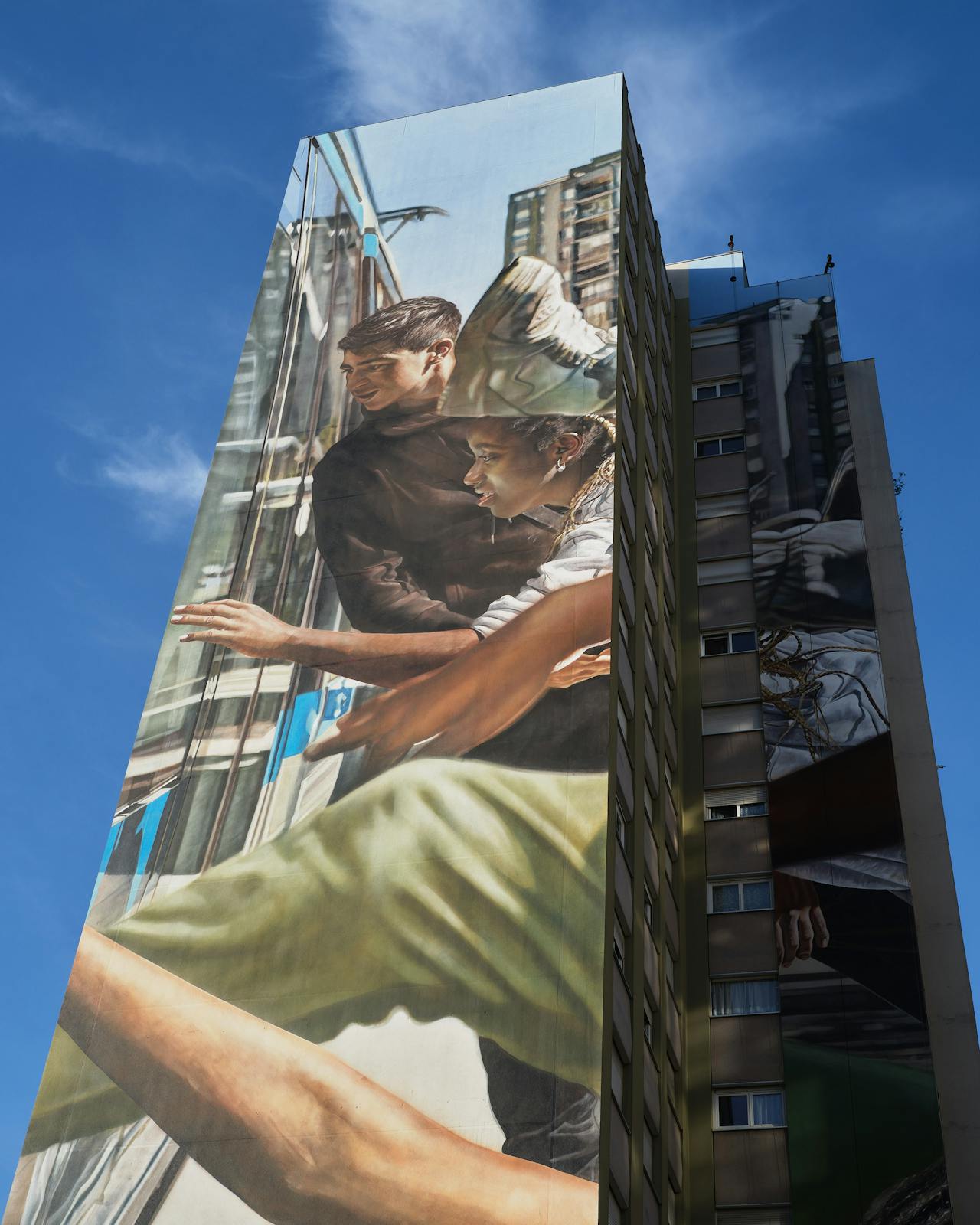
Completed for Grenoble Street Art Festival in October 2022.
L'eau - Martigny
Martigny, Switzerland, 2021
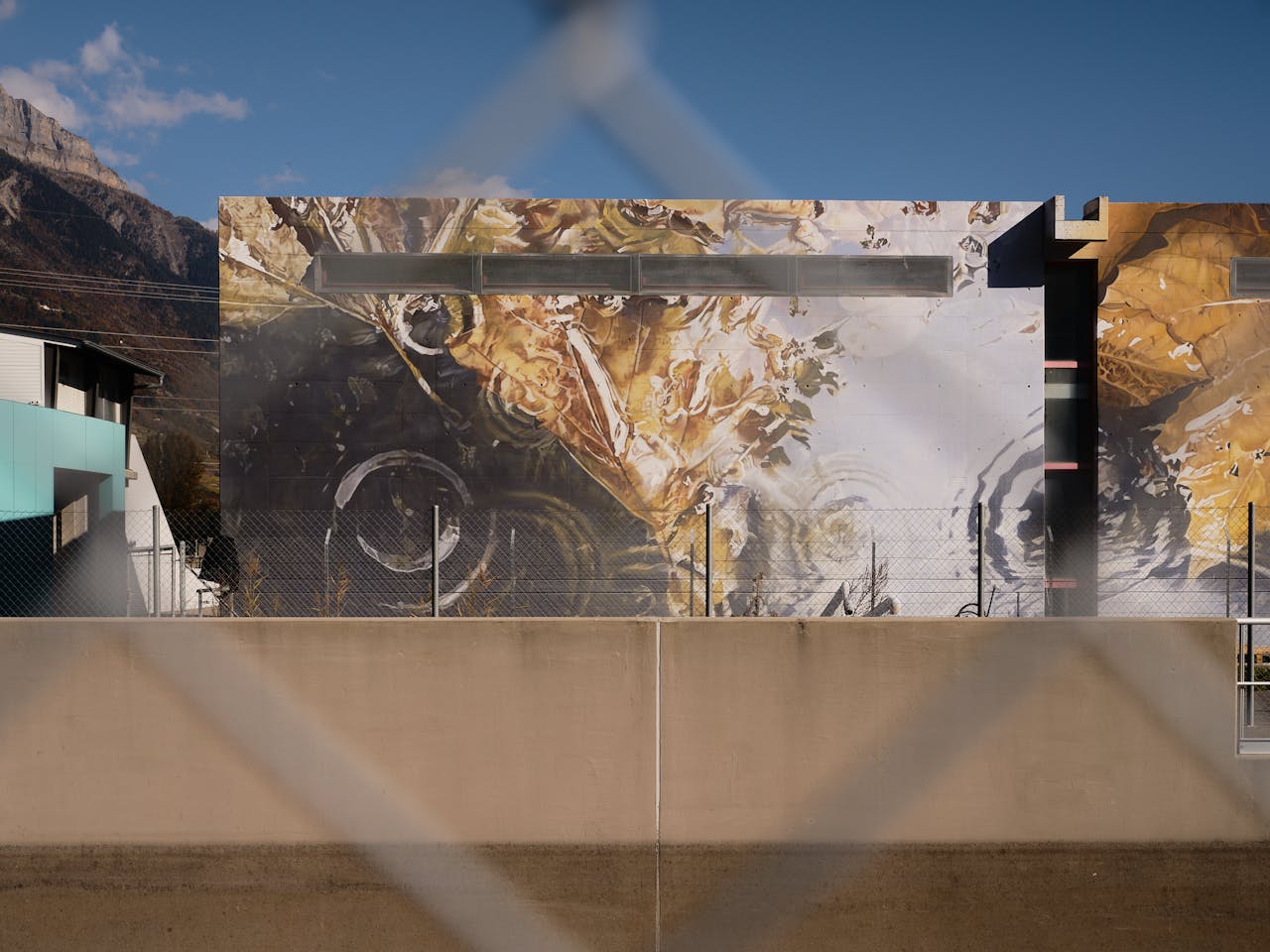
The concept explores a site-specific story relating to the Water...
Monuments Project - Minnesota
Mankato, Minnesota, 2020
Minnesota’s largest mural, this artwork is installed at the Ardent...
Monuments Project - Iowa
Fort Dodge, Iowa, 2018
The largest mural in the state of Iowa, this 360-degree mural on...
The Gods of Dharavi
Mumbai, India, 2017
A collaborative concept with the Slum Gods crew - developed on...
FestiWall
Ragusa, Sicily, Italy, 2017
Commissioned for the 2017 FestiWall public art festival, this...
Coonalpyn
Coonalpyn, South Australia, 2017
Commissioned by Coorong District Council at the Viterra active...
Frontline
Avdeevka, Ukraine, 2016
Painted for Art United Us project in the front line town of...
Mexicable Project, Part I
Ecatepec de Morelos, Mexico , 2016
Part of a series commissioned by Konect1 to launch the Mexicable...
Crystal Ship
Oostende, Belgium, 2016
Painted for the first edition of The Crystal Ship arts festival in...
Brim Silo Project
Brim, Victoria, Australia, 2016
The Brim silo project undertaken by Guido van Helten & Juddy Roller...
Last meal on Halvmåneøya
Svalbard, Norway, 2015
Titled Last meal on Halvmåneøya (Half Moon Island) this work was...
Wall to Wall Festival
Benalla, Victoria, 2015
This work explores the use of old photographs in the modern...
Akureyravaka
Akureyri, Iceland, 2014
'Painted for Akureyrarvaka Menningarnótt (culture night) in 2014...














